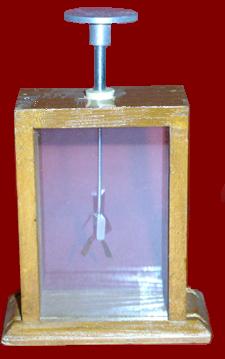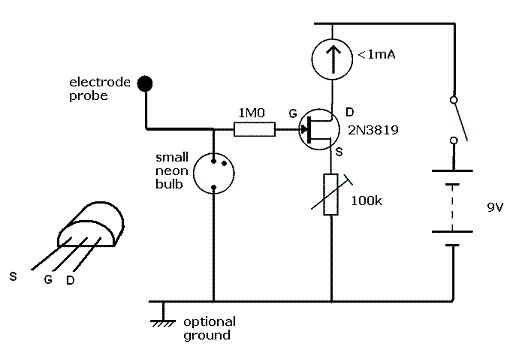|
|
 |
|
Every physics student knows about the gold-leaf electroscope from lessons in electrostatics, the picture on the right is of one dating from the latter part of the Victorian era, or the early part of the 20th century. Although it is an elegantly simple device, it does have its limitations, and they are a bit of a pain if the gold-leaf needs replacing. Nowadays the “gold” is actually Dutch metal, an alloy of copper and zinc. Repairing a gold-leaf electroscope If you have to repair a gold-leaf electroscope then click here for a .pdf document guide. An alternative As an alternative, it is possible to buy an electronic equivalent, although personally I would still let a class try the “real thing”. Unfortunately the electronic versions available tend to be expensive for what they really are, so I am going to present a cheap alternative, The project is based on some circuits I found on the Internet. http://www.techlib.com/Karen/misc.htm#Electrometer http://www.vk2zay.net/article/9 http://www.electronicsteacher.com/circuits-and-diagrams/miscellaneous-schematics Actually I finally used Karen’s circuit, because it’s simple and it works well! The only diffference is that I used a centre zero meter. I also raised the value of the source resistor. The 1M0 gate resistor is there to protect the fet, it doesn’t affect the operation. Don’t omit the neon bulb, as it is there to bias the gate of the fet, despite the fact that it is a gas-filled bulb it actually has a very high resistance, so high that you probably wouldn’t be able to buy one! In operation this electrometer is extremely sensitive, in fact, depending on the range of the meter it maybe too sensitive, in which case a 10k preset might be connected in series with the meter to adjust sensitivity, or you could try shunting the meter with a parallel resistor of a few hundred ohms. Now to a few practical points. First don’t attempt to make a printed circuit board, for two reasons: one it’s not worth the effort and two the resistance at the gate of the fet needs to be extremely high. Instead, simply glue the fet upside down onto a small piece of pcb, and solder the components in place, leaving them self-supporting. In fact my version proved to be so sensitive that I though it might be possible to take the idea further and see if it would work with an ionisation chamber to detect alpha particles. It worked so how about checking the Ionisation chamber page.
I didn’t know where else to put this link, but for now it will be here: Kay & Laby’s “Tables of Physical and Chemical Constants” is available online: http://www.kayelaby.npl.co.uk/ |
| [Home] [Famous hams] [Links] [Non radio] [Circuits] [Xtal calibrator] [Electroscope] [Ionisation chamber] [Software] [News] [WX sats.] [National societies] [Special Interest] [NBTV] [Safety] [Radio museums] [Amateur science] |


















